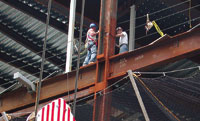 |
| (Photo by Guy Lawrence for ENR) |
According to an annual report compiled exclusively for ENR by New York City-based insurance broker Marsh USA Inc., rate increases across the U.S. outnumber declines. This years survey shows that ironworkers have the most expensive workers comp rate in the nation with a national average rate of $40.68 per $100 of payroll for structural steel erection. Ironworkers comp rates also are posting some of the largest increases, according to the Marsh survey. This years 6% increase recaptured 2003s entire decline and built on rate increases that totaled 16% between 2000 and 2002.
The rate for bricklayers rose 1.4%, to $15.76, after slipping about 2% the previous year. Rates for carpenters declined 5%, to $18.99, after increasing 7% in 2003 and 3% in 2002.
By comparison, rates for all industries also went up, but the pace of the increase is slowing, according to Fitch Inc., the ratings agency. Over the next year or so, prices should remain flat or decline, a trend consistent with all forms of property and casualty insurance, the agency says.
Nationwide, eight states have filed for rate increases and six for decreases, reports Peter M. Burton, senior division executive at the nonprofit National Council on Compensation Insurance Inc., Boca Raton, Fla. Oklahoma leads the pack with an 11.5% increase, followed by Alaska with 9.5%. On the flip side, Colorado has filed for a 4.5% rate cut, Hawaii a 3% decrease and Florida a 2.9% cut, Burton reports.
Insurers want increases because they continue to suffer unexpectedly high claims payouts. By jacking up prices and following stricter underwriting practices in 2003, they drove the loss ratio down to 108%, an improvement on 2002's 111% and 2001s 122%, says Fitch.
Insurers cant always push prices up as fast as they would like. In New York this summer, for example, Superintendent of Insurance Gregory V. Serio turned down a request for a 29.3% increase in overall workers compensation rates from the New York Compensation Insurance Rating Board. Serio questioned the need for such a large rate increase because he says insurers have been consistently profitable in recent years, failed to take into account new efficiencies introduced into the New York claims system and hadnt yet taken advantage of new anti-fraud measures.
|
VIEW RELATED DATA |
| Workers' Compensation Rates |
|
VIEW MORE ARTICLES FROM THIRD QUARTERLY COST REPORT |
| Summary: Inflation Batters Building Costs |
| Indexes: Inflation triples last years pace |
| Equipment: Strong demand hits prices |
| Labor: Tackling the cost of drug use |
| VIEW EXPANDED COST STATISTICS |
| ENR is now offering more of our unique U.S. construction cost statistics on the web. click here to view more >> |
Reform Results Awaited
Across the country, reforms aimed at slowing rate hikes have been adopted. In Florida, the effectiveness of reforms adopted by lawmakers in October 2003 still are being weighed. "Anecdotally, it looks like the amount of claims is being reduced," says Burton. "Thats taken as a positive sign." Florida cut premiums 14% after reforms kicked in last year, but Burton notes that improved injury rates drove down rates prior to the reforms.
Still, the situation in Florida is far from bright, especially for smaller employers. Even though Floridas benefits are comparatively low, its premiums high and insurers have not abandoned the Florida market, some insurers are not renewing unprofitable accounts, says Ray Dorsey, senior vice president in broker Acordia Inc.s West Palm Beach office. Smaller contractors are facing a tough market "because insurers think theres not enough premium to support the risk."
Contractors are cautious but encouraged by Californias attempt to shake up its $29-billion system, widely criticized for its high costs, inadequate benefits and excessive litigation. "Generally what Im hearing is that the workers comp rate issue...
nsurers continued to seek higher prices for workers compensation policies, driving up rates for construction crafts an average of 2.8% in 2004 so far. Continuing losses mean that insurers will keep the pressure on rates. They would have risen even higher, some believe, were it not for tougher scrutiny of claims that employers and insurers hope will limit payouts.
Post a comment to this article
Report Abusive Comment